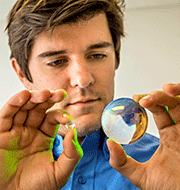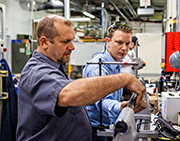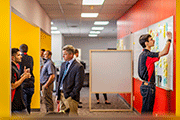E-Archive
Cover Page
in Vol. 20 - July Issue - Year 2019
Transforming Laser Peening

Head of Mechanical Engineering Gary Grossenbacher reviews a custom laser peening tool design with Mechanical Engineer Devin Hilty. LSP Technologies now develops specialized laser beam delivery tools for addressing large stationary components, complex geometries and hard-to-reach surfaces.

Dr. Jeff Dulaney, President and CEO of LSP Technologies, leans on some friendly robots under configuration for a Procudo® Laser Peening System being assembled at the company’s Dublin, Ohio, build room.

Laser Optical Designer Tim Gorman shows how much smaller the micro-lenses and mirrors must be to deliver laser peening to hard-to-reach parts.

Production Manager Andy Kerber helps Stan Bovid, Director of Materials Research, pinpoint exact measurement for laser peen forming for a new customer solution. Laser peen forming uses the precision and power of laser plasma explosions to adjust the straightness and curvature of metal parts, from small castings to hull sections for high-performance naval vessels.

Automation Engineer Rohit Joshi, left, and Vice President of Engineering Mark Bloomberg take time to consider a problem from a different angle. Informal conversations fit the workstyle and speed the issue resolution process in huddle halls and open offices at the new headquarters of LSP Technologies.
LSP Technologies shares the secrets of rapid growth in custom laser peening solutions.
LSP Technologies Inc. has nearly tripled in size and sales due to a fundamental shift in its business strategy. In addition to its robust laser peening services business, LSPT now provides laser peening equipment and custom-engineered laser peening solutions. But perhaps the real secret to its success is a high-performance team culture.
Just three years ago, LSPT became the only company in the world to offer a turnkey laser peening system. Today, LSPT offers custom solutions that allow customers to deal with large stationary parts, hidden surfaces, complex geometries, and hazardous environments.
The proliferation of laser peening technology took a giant step forward in 2015 with the introduction of the Procudo® Laser Peening System, the world’s first and only commercial, high power, diode-pumped laser peening system. The first three Procudo® Laser Peening Systems were installed on three different continents: at LSP Technologies’ facility in Dublin Ohio, at Guangdong University of Technology in Guangzhou, China, and at the Center of Applied Aeronautical Research in Hamburg, Germany (See MFN International, July 2018 cover story).
This year, a Chinese auto components manufacturer signed a joint venture agreement with LSP Technologies for the purpose of providing laser peening services in China utilizing Procudo® Laser Peening Systems. That joint venture, Shandong Maitelaisi Metal Surface Technology Co., Ltd. (MTLS), is now a reality. MTLS has a 100,000sqft facility, now in final stages of construction, which will open this fall in Weifang, China.
As soon as LSP Technologies introduced the Procudo® Laser Peening System, the market demand for customized equipment and solutions emerged, fueling LSPT’s continued growth and rapid transformation.
LSPT is now helping customers explore innovative, individualized, and highly engineered solutions that deliver laser peening to complex equipment, difficult-to-reach surfaces, and hazardous environments. LSPT is developing custom-engineered laser peening solutions across diverse industries from the automotive to aerospace to power generation and tooling. The physical challenges posed by the need for peening in these applications require radical changes in both equipment design and innovation.
Dr. Jeff Dulaney, LSPT’s Founder, President, and CEO, explains that meeting the demand for highly engineered, customized laser peening solutions requires a unique cultural transformation that enables innovation and close customer relationships to meet customers’ needs and successfully navigate continued growth.
"We’ve worked for more than 20 years to develop, commercialize, and popularize laser peening technology, because potential for the technology has always been there," said Dr. Dulaney. "Now we are leveraging the benefits of our Humble, Hungry, and Smart culture to reach more customers and unlock the technology’s potential."
Some people may question the value of soft skills and cultural attributes in addressing industrial issues, Dr. Dulaney said, so LSPT has done quite a few things that fill in the concrete details, including the company’s move to a new headquarters with triple the space and a new open floor plan. Configuring the building and organizing the work turned out to be just the right fit for a fast-growth, high-innovation culture.
"The building had a lot of potential spaces for executive offices, but from the Chief Operating Officer on down we’re in the open office space, not closed offices," explained Mark Bloomberg, Vice President of Engineering. "That means you overhear each other, and there’s a lot of conversation going on. In the huddle halls, focus rooms, meeting rooms, and project areas, so much of this conversation goes on informally. There are so many impromptu meetings to sketch out how we’re going to solve problems.
"Very intentionally, we’ve set up the engineering organization to work in a way that is more self-directed, which enables the organization to identify and solve problems quickly. It’s not a top-down directing-type style, where you have one person or a couple of people managing all the chess pieces on the board. We rely on the size and scale of our organization to adapt quickly."
Moreover, engineering found the hidden power of failure, Bloomberg said. "We want to fail fast. That means we want to know quickly when what we’re doing is not working. We bring ideas to our clients before they are fully developed with what our thinking is, and as a result we get very quick feedback from them as to whether that’s really what they’re after. We don’t view it as a failure if the customer says ‘No, that’s not really what I want.’ That’s a success."
LSPT took on two major projects – one involving specialized laser peening equipment for aerospace giant Airbus, and the other in mission-critical nuclear power generation services. Both became multi-year efforts involving a much larger engineering cohort, so LSPT began expanding from a core of 22 employees 30 months ago to 59 today.
"Not so long ago, we wondered how much of this new business would come through," Dr. Dulaney said. "We were bidding on multiple projects that would change the size of our team and the focus of our work, even if we won only one of them. All were projects that other companies had either avoided or already tried and failed. It turned out we won all these significant bids, and then we had a new challenge: recruiting enough hungry, humble, and smart people to help us realize some very ambitious plans. I felt so strongly that each new addition to our team was a good cultural fit that I asked one of my Board Members and trusted advisors to lead our talent acquisition effort."
"Yes, we were confident leaders in laser peening technology, and we had a big lead in producing commercial laser peening equipment. But we were still a small business, and the challenging projects and opportunities opening up would inevitably change us. We had to gear up as a highly talented and ambitious engineering firm, offering custom solutions and innovative equipment as a new core part of our business."
Historically, LSP Technologies used a fixed laser beam and manipulated the parts in the beam path using robots. Today, the company is using unique methods of moving the laser beam through articulating arms, fiber optics, or sometimes incredibly small mirrors and lenses. The customers’ precision requirements, variable geometries, and the hard-to-reach surfaces of their components demanded a laser beam delivery transformation and an innovative custom laser peening solution.
To make those innovations possible, the company has onboarded new mechanical engineers, electrical engineers, physicists, optical designers, automation and controls experts, laser technicians, and laser equipment assemblers at an astonishing rate, tripling the engineering staff between April 2018 and January 2019.
"I feel very fortunate that we have been able to attract this level of talent," said Eric Collet, Chief Operating Officer. "To recruit them, we told a very compelling story, and our business model looks a lot more like a startup than a 20-year-old established business. That’s appealing to everyone who likes to create new things."
LSPT ramped up staffing of new engineers and technicians quickly, and they learned more rapidly than anyone predicted, Collet said. "This experience has shattered all of my previous preconceived notions around the learning curve and how long it takes new talent to assimilate and become productive, because folks have joined our business and added significant value immediately," he said. "I feel very confident that we have the internal horsepower now and the capacity to design very customized and sometimes very complex solutions, if that’s what our customers are requiring of us."
"It ties back to the culture," Bloomberg said. "The people that we’re bringing into the business all share that humble, hungry, and smart mindset. When we bring someone on, we say, here is a meaty problem we must solve, and we need your help right away. So people are given very challenging and complex problems immediately, and we’ve been very successful getting them to contribute significantly to our business in short order and solving very challenging customer problems."
Six months after the move to new headquarters, Dr. Dulaney still spends little time in an office, joining informal huddles, one-on-one discussions with engineers, and in meeting rooms preparing for delivery of new designs and products.
"My message to the teams in those meetings is to think about the roots of problems and challenges, as well as looking at issues from a companywide perspective. We can’t just take the first solution offered. And if you’re a mechanical engineer, the solution you offer must be elegant, fitting in with optical requirements, automation and controls, and of course the customer’s deadline and costs," Dr. Dulaney said.
Much of the work involved entirely new tools, said Gary Grossenbacher, Chief Mechanical Engineer. "If you must deliver the laser beam to a large part, or a very small part, with unique geometry, then you need a system in which the laser goes right to the part. It has changed the way we have to design and then manufacture all the tooling. That’s really where our change is.
"I can see a few unique situations where we get the opportunity to go into a large manufacturer and install a standard Procudo® Laser Peening System, even more than one in multiple installations. But I also see many more opportunities for companies that want a unique design. Where our standard system might have a 300sqft footprint and deliver a pulse once every second, our custom solutions might have to fit in less than 50sqft, and we can deliver a pulse 20 times a second. It’s much more efficient, and it’s the whole point of being able to process faster and cheaper for the customer."
"One of the strategic advantages of laser peening is precision," said Collet. "We have precision modeling and parameters customized for the individual part, but customers want more," he said. "We know that if all the components of laser peening are delivered to the target appropriately, a successful process will result. Our ability to capture that process data, archive it, integrate it, and upload it to a customer’s infrastructure could be very important. Anyone who is interested in imparting residual stress through laser peening wants to know that the operating parameters were correct and have the confidence that the desired results were achieved."
"We can guarantee that high level of precision," President and CEO Jeff Dulaney said. "In metal surface technologies, laser peening goes deeper and improves resistance to corrosion and cracking more than five times the useful life of conventional technologies. That’s the technological difference. But we believe the reason we’ve been able to collaborate with customers so successfully is that unique blend of business strategy, leading intellectual property, and our humble, hungry, and smart culture."
For Information:
LSP Technologies, Inc.
6161 Shamrock Court
Dublin, Ohio 43016-1275, USA
Tel. +1.614.718 3000, Fax +1.614.718 3007
E-mail: dlahrman@lspt.com
www.lsptechnologies.com



























